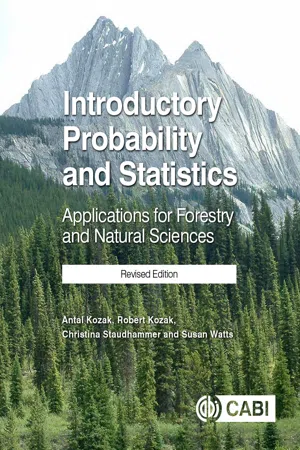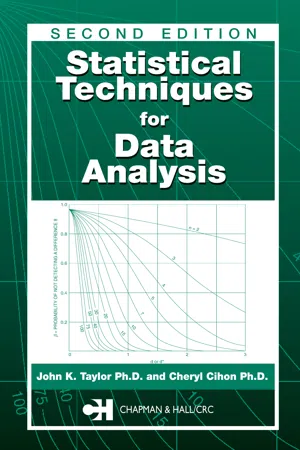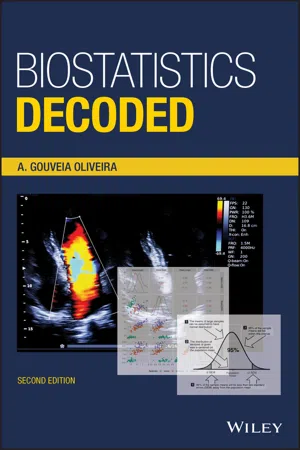Technology & Engineering
Standard Deviation of Random Variable
The standard deviation of a random variable measures the amount of variation or dispersion of the values of the variable from the mean. It provides a way to quantify the uncertainty or risk associated with the random variable. In engineering and technology, understanding the standard deviation of a random variable is crucial for analyzing and predicting the behavior of systems and processes.
Written by Perlego with AI-assistance
Related key terms
Related key terms
1 of 4
Related key terms
1 of 3
7 Key excerpts on "Standard Deviation of Random Variable"
- eBook - ePub
Introductory Probability and Statistics
Applications for Forestry and Natural Sciences (Revised Edition)
- Robert Kozak, Antal Kozak, Christina Staudhammer, Susan Watts(Authors)
- 2019(Publication Date)
- CAB International(Publisher)
Chapter 2 ) because, typically, distributions of random variables are not bell-shaped and symmetrical. Using probability theory, Chebyshev’s Theorem can be re-stated as:This expression means the probability that a random variable takes on a value within k standard deviations of the mean is at least (1 – 1/k 2 ).Example 4.10. Using Eqn 4.8 , find the variance and standard deviation of the number of dots showing when rolling a die.Example 4.11. In Example 4.5 , we randomly selected 4 seedlings from a group of 9, where 3 were stunted. We then counted the number of normally growing seedlings in our sample of three. Find the variance and the standard deviation of the number of normally growing seedlings.Like the mean, the equation to calculate the variance for continuous random variables requires an understanding of integral calculus. The equation is given here for reference; however, an example is not given, as it is beyond the scope of this book.As in Eqn 4.3 with the mean, we can compute the variance of a function of a random variable. If g (X ) is a function of a random variable, X , which has a probability function of f (x ), the variance of g (X ) is:and its working formula is:Example 4.12. In Example 4.8 , X was a random variable describing the number of heads counted when tossing 3 coins and g (X ) was defined as 4x + 3. Find the variance and the standard deviation of g (X ).In the case of joint probability distributions, the measure of joint variation between two random variables is called the covariance - eBook - ePub
- Lance B. Coleman(Author)
- 2020(Publication Date)
- ASQ Quality Press(Publisher)
range is the simplest measure of dispersion. It is the difference between the maximum and minimum values in an observed data set. Since it is based on only two values from a data set, the measurement of range is most useful when the number of observations or values is small (ten or fewer).Standard DeviationStandard deviation , the most important measure of variation, measures the extent of dispersion around the zone of central tendency. For samples from a normal distribution, it is defined as the resulting value of the square root of the sum of the squares of the observed values, minus the arithmetic mean (numerator), divided by the total number of observations, minus one (denominator). The standard deviation of a sample of data is given as:s = standard deviationn = number of samples (observations or data points)X = value measured= average value measuredCoefficient of VariationThe final measure of dispersion, coefficient of variation , is the standard deviation divided by the mean. Variance is the guaranteed existence of a difference between any two items or observations. The concept of variation states that no two observed items will ever be identical.Frequency DistributionsA frequency distribution is a tool for presenting data in a form that clearly demonstrates the relative frequency of the occurrence of values as well as the central tendency and dispersion of the data. Raw data are divided into classes to determine the number of values in a class or class frequency. The data are arranged by classes, with the corresponding frequencies in a table called a frequency distribution. When organized in this manner, the data are referred to as grouped data, as in Table 20.1 .The data in this table appear to be normally distributed. Even without con- structing a histogram or calculating the average, the values appear to be centered around the value 18. In fact, the arithmetic average of these values is 18.02.The histogram in Figure 20.1 - eBook - ePub
- (Author)
- 2023(Publication Date)
- Wiley(Publisher)
The expected value is our forecast. Because we are discussing random quantities, we cannot count on an individual forecast being realized (although we hope that, on average, forecasts will be accurate). It is important, as a result, to measure the risk we face. Variance and standard deviation measure the dispersion of outcomes around the expected value or forecast.The variance of a random variable is the expected value (the probability-weighted average) of squared deviations from the random variable’s expected value:Equation 2.σ2= EXX - EX2The two notations for variance are σ2 (X) and Var(X).Variance is a number greater than or equal to 0 because it is the sum of squared terms. If variance is 0, there is no dispersion or risk. The outcome is certain, and the quantity X is not random at all. Variance greater than 0 indicates dispersion of outcomes. Increasing variance indicates increasing dispersion, all else being equal.The following equation summarizes the calculation of variance: Equation 3,σ 2X= PX 1+ P2X 1− EXX 22X 2− EX+ … + PX n=2X n− EXP∑i = 1nX i2X i− EXwhere Xi is one of n possible outcomes of the discrete random variable X.Variance of X is a quantity in the squared units of X. For example, if the random variable is return in percent, variance of return is in units of percent squared. Standard deviation is easier to interpret than variance because it is in the same units as the random variable. Standard deviation - eBook - ePub
- John K. Taylor, Cheryl Cihon(Authors)
- 2004(Publication Date)
- Chapman and Hall/CRC(Publisher)
2 . The symbol V is sometimes used to designate variance.Ordinarily one is not dealing with a population, but rather with a sample of n individuals of the population. The individual measured values may be indicated by the symbols X1 , X2 , Xn .The sample mean, (called X bar), calculated as shown in the figure, is hopefully a good estimate of the population mean–that is why the measurements were made in the first place! One can calculate the sample standard deviation, s, using the formula shown in the figure. Likewise one can calculate the sample variance, s2 , as shown. Of course, one can use a simple calculator to do this, as indicated by PUSH BUTTON. This convenience is good because arithmetic is hard work and one may make mistakes. However, one should make a few calculations by the formula just to understand and appreciate what the calculator is doing.Remember that s is an estimate of the standard deviation of the population and that it is not σ. It is often called “the standard deviation”, maybe because the term ‘estimate of the standard deviation’ is cumbersome. It is, of course, the sample-based standard deviation but that term is also cumbersome. The standard deviation and its estimates always have the same units as those for X. When considering variability, a dimensionless quantity, the coefficient of variation, cv, is frequently encountered. It is simplyIf one knows cv and the level, X, s can be calculated.Figure 4.1. Population values and sample estimates.Another term frequently used is called the relative standard deviation, RSD, and it is calculated asFigure 4.2. Distribution of means.RSD = cv×100The relative standard deviation is thus expressed as a percent. There could be room for confusion when results are reported on a percentage basis, as the percentage of sulfur in a coal sample, for example. Here the value for s could be in units of percent. In such cases, one can make the distinction by using the terms % relative and % absolute. - eBook - ePub
- John K. Taylor(Author)
- 2018(Publication Date)
- Routledge(Publisher)
On considering the above, it should be obvious that even the best of measurements will differ from each other, whether made by the same or different laboratories or scientists. The serious analytical chemist often needs to answer questions concerning the confidence that can be placed in measurement data and the significance of apparent differences resulting from measurements. The various equations given in this chapter take into account both the expected variability within populations and the uncertainties in the estimates of the population parameters that must be considered when answering such questions.Estimation of Standard DeviationThe basic parameters that characterize a population (universe) of samples or measurements on a given sample are the mean, μ, and the standard deviation, σ. Unless the entire population is examined, μ and σ cannot be known but are estimated from a sample(s) randomly selected (assumed) from it. The result is a sample mean,X ¯, and an estimate of the standard deviation, s, which must be used if such things as confidence intervals, population characteristics, tolerance intervals, comparisons of precision, and the significance of apparent discrepancies in measured values are to be evaluated. The variance, which is simply the standard deviation squared (e.g., σ2 , s2 ) is used in some statistical calculations later in this chapter.The standard deviation and its estimates represent the dispersion of the members of a population (the measured values) around the mean. The population (or sample of the population) that it represents must always be clearly identified; otherwise one cannot know to what it refers. In the case of measurement, it is helpful to consider a specific methodology, in a state of statistical control, as a generator of a population of values of which the data set at any time is a sample. If anything about the measurement process is changed on various occasions, the population produced may differ, as well as the standard deviation and mean. Such possibilities must be considered when statistically analyzing data sets. In the case of samples of materials, the parent material must be clearly identified when the dispersion of individual samples is discussed. - eBook - ePub
- Joe F. Hair Jr., Michael Page, Niek Brunsveld(Authors)
- 2019(Publication Date)
- Routledge(Publisher)
variance . It is useful for describing the variability of the distribution and is a good index of the degree of dispersion. The variance is equal to 0 if each and every respondent in the distribution is the same as the mean. The variance becomes larger as the observations tend to differ increasingly from one another and from the mean.Standard Deviation
The variance is used often in statistics, but it does have a major drawback. The variance is a unit of measurement that has been squared. For example, if we measure the number of colas consumed in a day and wish to calculate an average for the sample of respondents, the mean will be the average number of colas, and the variance will be in squared numbers. To overcome the problem of having the measure of dispersion in squared units instead of the original measurement units, we use the square root of the variance, which is called the standard deviation. The standard deviation describes the spread or variability of the sample distribution values from the mean and is perhaps the most valuable index of dispersion.To obtain the squared deviation, we square the individual deviation scores before adding them (squaring a negative number produces a positive result). After the sum of the squared deviations is determined, the result is divided by the number of respondents minus 1. The number 1 is subtracted from the number of respondents to help produce an unbiased estimate of the standard deviation. If the estimated standard deviation is large, the responses in a sample distribution of numbers do not fall very close to the mean of the distribution. If the estimated standard deviation is small, you know that the distribution values are close to the mean. - eBook - ePub
- A. Gouveia Oliveira(Author)
- 2020(Publication Date)
- Wiley(Publisher)
Actually, they pose so many problems that it is standard mathematical practice to square a value when one wants the sign removed. Let us apply that method to the mean deviation. Instead of using the absolute value of the differences about the mean, let us square those differences and average the results. We will get a quantity that is also a measure of dispersion. This quantity is called the variance. The way to compute the variance is, therefore, first to find the mean, then subtract each value from the mean, square the result, and add all those values. The resulting quantity is called the sum of squares about the mean, or just the sum of squares. Finally, we divide the sum of squares by the number of observations to get the variance. Because the differences are squared, the variance is also expressed as a square of the attribute’s units, something strange like mmol 2 /l 2. This is not a problem when we use the variance for calculations, but when in presentations it would be rather odd to report squared units. To put things right we have to convert these awkward units into the original units by taking the square root of the variance. This new result is also a measure of dispersion and is called the standard deviation. As a measure of dispersion, the standard deviation is single valued and stable, but what can be said about its interpretability? Let us see: the standard deviation is the square root of the average of the squared differences between individual values and the mean. It is not easy to understand what this quantity really represents. However, the standard deviation is the most popular of all measures of dispersion. Why is that? One important reason is that the standard deviation has a large number of interesting mathematical properties. The other important reason is that, actually, the standard deviation has a straightforward interpretation, very much along the lines given earlier to the value of the mean deviation
Index pages curate the most relevant extracts from our library of academic textbooks. They’ve been created using an in-house natural language model (NLM), each adding context and meaning to key research topics.
Explore more topic indexes
Explore more topic indexes
1 of 6
Explore more topic indexes
1 of 4






